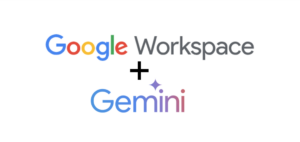Google Pressures Microsoft 365 By Adding Gemini To Workspace For (Mostly) Free

On February 2024, I wrote a blog post declaring “You’re not switching to Google Workspace to use Gemini — yet.” Google aims to change that. Today, the company announced that it will include “the best of Google AI in Workspace Business and Enterprise plans” without the need to purchase an add-on. (Previously, Gemini for Workspace plans cost $20/user/month.) Google will now go to market with Workspace as a fully genAI-enabled productivity and collaboration suite, in contrast to Microsoft’s $30/user/month Microsoft 365 Copilot add-on. Google will raise its Workspace price, nominally, from $12/user/month to $14/user/month.
Workforce Generative AI Can Be A Feature, Not A Product
Driving higher productivity with generative AI has been no easy task. Approaches that embed genAI directly into the flow of work, like Microsoft 365 Copilot and Google Workspace, see higher usage than solutions that require employees to switch between applications. (Who wants to compose an email in a separate browser window, then cut and paste?) But until Google’s announcement, embedded solutions required expensive add-on licenses. Google’s bold move here:
- Reminds us that products can evolve into features. Forrester has long tracked the phenomenon of products becoming features; in 2014, we wrote about how Amazon Prime turned the music business into a feature of its Prime platform subscription. In 2020, we wrote about how the enterprise AI market isn’t as big as you think it is, because a lot of AI was already being expressed as a feature of existing software. Google is betting that the same will happen with genAI productivity and collaboration.
- Shows a case of a viable offering seeking monetization in other ways. Other companies in this space follow a similar approach. Zoom, for example, added genAI features to its core platform without an add-on subscription. The approach assumes that value can be captured via higher market share (acquiring customers) and retention (lower churn) effects. Google, with its small footprint, should be focused on the former.
- Tempts us to say that Google failed, but it could be a competitive boon. Some headlines will likely call this “commodification” or say that Google simply gave up because it couldn’t sell Gemini for Workspace. While there’s an element of truth to both, Google’s sales channel and customers may well celebrate. The move instantly refocuses Google’s value proposition and pricing, though, as we’ll see, it still won’t be for everyone.
Google Workspace Belongs In Some Purchasing Discussions
Yesterday, we released a new report, How To Build A Pragmatic Microsoft 365 Copilot Program, in which we argue that making Copilot valuable faces numerous obstacles, from measuring ROI to technical and performance challenges to a high employee training burden that isn’t being met. So M365 Copilot has vulnerabilities. But Workspace does, too; the training burden applies equally to employees using Gemini features, for example.
It’s likely still not time for you to switch from Microsoft 365 to Google Workspace. But we also believe that:
- Google Workspace will become more competitive with Microsoft 365. Attractive pricing matters, especially when, at its new price, Google brings credible performance, a small but nontrivial roster of enterprise clients, and also some differentiated genAI features (including the innovative NotebookLM and Vids, a video-creation genAI tool).
- Microsoft 365 is embedded and has enduring strengths. Despite Google’s appeal, Microsoft 365’s ubiquity and quality remain hard to dislodge. Migrating M365 documents, SharePoint sites, and macros to Workspace remains a monumental effort. Plus, Microsoft 365 and M365 Copilot have genuine advocates among buyers. In addition to Copilot Studio, a range of Microsoft Azure services and development tools allows enterprises to create a wide range of applications. Increasingly, those applications can be accessed from inside Copilot.
- Microsoft will, however, feel pricing pressure. Building a business case for M365 Copilot that convinces the CFO to expand licenses broadly remains challenging. At most organizations, cohorts of users abandon Copilot, leading to employee license transfers, higher than expected training burdens, and less than productive outcomes. How long can Microsoft hold the line — and for how long — on $30/user/month? We’re betting the pricing strategy evolves.
Next Steps For You? Let’s Talk
You should consider Workspace if you are: 1) a startup (companies starting from scratch with little Microsoft legacy are more likely to adopt); 2) an SMB (small and medium businesses need fewer features and are more price-sensitive); 3) willing to segment your workforce (specific departments might benefit, even if the rest of the company uses Microsoft 365); and/or 4) in need of specific Google innovations, like Vids or NotebookLM. But regardless of whether you are already knee-deep in M365 Copilot, considering Workspace, or still haven’t jumped into any of these tools, your next steps will depend on your resources, needs, and AI readiness. Reach out to schedule a guidance session with me, and let’s get you where you need to go.
